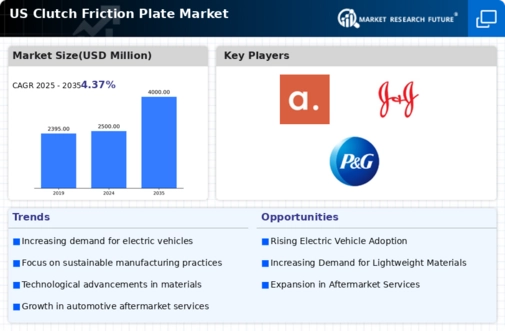Rising Automotive Production
The increasing production of vehicles in the US is a primary driver for the clutch friction-plate market. As manufacturers ramp up output to meet consumer demand, the need for high-quality clutch components becomes essential. In 2025, the automotive sector is projected to grow by approximately 5%, leading to a corresponding rise in the demand for clutch friction-plates. This growth is fueled by a combination of factors, including a recovering economy and consumer preferences for new vehicles. Consequently, the clutch friction-plate market is likely to experience heightened activity as automakers seek reliable suppliers to ensure the performance and longevity of their vehicles. The emphasis on quality and durability in clutch components is expected to drive innovation and competition among manufacturers, further propelling market growth.
Growth of Aftermarket Services
The expansion of aftermarket services is a notable driver for the clutch friction-plate market. As vehicle ownership increases, so does the demand for replacement parts and maintenance services. In 2025, the aftermarket segment is projected to grow by approximately 7%, indicating a robust market for clutch friction-plates. This growth is fueled by the rising number of older vehicles on the road, which require regular maintenance and part replacements. The clutch friction-plate market stands to benefit from this trend, as consumers seek reliable and durable replacement parts to ensure their vehicles operate efficiently. Additionally, the increasing popularity of DIY maintenance among consumers may further boost demand for aftermarket clutch components.
Regulatory Compliance and Standards
The clutch friction-plate market is also driven by stringent regulatory compliance and industry standards. In the US, automotive regulations are becoming increasingly rigorous, particularly concerning safety and emissions. Manufacturers are required to adhere to these regulations, which often necessitates the use of high-quality clutch components that meet specific performance criteria. As of 2025, it is anticipated that compliance costs will rise, prompting manufacturers to invest in superior clutch friction-plates that align with regulatory demands. This trend not only ensures safety but also enhances the overall reliability of vehicles. The clutch friction-plate market must navigate these complexities, as failure to comply could result in significant financial penalties and reputational damage.
Increased Focus on Vehicle Performance
The growing emphasis on vehicle performance and efficiency is significantly influencing the clutch friction-plate market. Consumers are increasingly seeking vehicles that offer superior handling, acceleration, and fuel efficiency. This trend compels manufacturers to invest in advanced clutch technologies that enhance performance. In 2025, it is estimated that the performance vehicle segment will account for around 30% of the total automotive market, thereby increasing the demand for high-performance clutch friction-plates. The clutch friction-plate market must adapt to these evolving consumer preferences by developing products that not only meet but exceed performance expectations. This focus on performance is likely to drive research and development efforts, leading to innovative solutions that cater to the needs of performance-oriented consumers.
Technological Innovations in Manufacturing
Technological advancements in manufacturing processes are reshaping the clutch friction-plate market. Innovations such as automation, advanced materials, and precision engineering are enhancing the production of clutch components. In 2025, it is expected that manufacturers will increasingly adopt these technologies to improve efficiency and reduce production costs. This shift not only allows for higher quality products but also enables faster response times to market demands. The clutch friction-plate market must embrace these technological changes to remain competitive. As manufacturers leverage new technologies, they can offer innovative products that meet the evolving needs of consumers, thereby driving growth in the market.














Leave a Comment